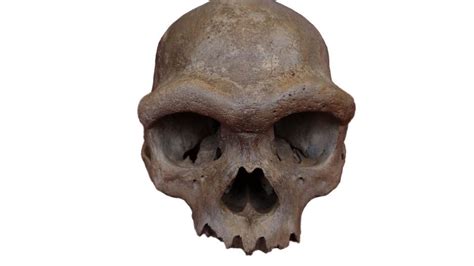
A massive skull discovered in China, dubbed “Dragon Man,” represents a previously unknown human lineage, potentially rewriting our understanding of human evolution and challenging the dominance of Neanderthals in the story of our closest relatives. Preliminary analysis suggests “Dragon Man,” or Homo longi, may be more closely related to Homo sapiens than Neanderthals are, sparking debate and prompting further research into this mysterious ancient hominin.
The nearly perfectly preserved cranium, discovered in the 1930s but only recently brought to the attention of scientists, possesses a unique combination of features. Its immense size, larger than any other known Homo species skull, robust brow ridge, and deep-set eyes are coupled with a relatively delicate face, setting it apart from Neanderthals and Denisovans, the other prominent hominin groups of the Pleistocene epoch. The discovery raises profound questions about the geographic distribution, interbreeding patterns, and evolutionary relationships of early humans and their extinct relatives.
The skull was reportedly found in the city of Harbin, Heilongjiang province, northeastern China, a region known for its harsh winters. The circumstances surrounding its discovery remain somewhat murky, adding to the enigma of “Dragon Man.” According to Professor Xijun Ni of the Hebei GEO University, who led the research, the skull was supposedly unearthed during the construction of a bridge over the Songhua River. To protect it from falling into the hands of the Japanese army, a Chinese laborer allegedly hid the skull, keeping it secret until his death, after which his family donated it to the university.
While the exact dating of the skull remains uncertain, geochemical analysis of sediment samples collected near the discovery site suggests it is at least 146,000 years old. This places “Dragon Man” in the Middle Pleistocene, a crucial period for human evolution characterized by significant climatic fluctuations and the dispersal of Homo species across Eurasia.
The implications of this discovery are far-reaching. If Homo longi is indeed more closely related to Homo sapiens than Neanderthals, it would necessitate a reassessment of the human evolutionary tree and potentially redefine our understanding of what it means to be human. The research team posits that Homo longi may even represent the elusive Denisovans, a hominin group known primarily from fragmentary DNA evidence found in Siberia and Tibet. This hypothesis, however, remains highly speculative and requires further genetic and fossil evidence to support it.
The unique morphology of the “Dragon Man” skull suggests that it belonged to a physically robust individual adapted to a cold environment. The large size of the skull indicates a correspondingly large brain, potentially indicative of advanced cognitive abilities. The combination of archaic and modern features observed in the skull challenges the traditional linear model of human evolution, which posits a straightforward progression from primitive to advanced forms. Instead, it supports a more complex and nuanced view of human evolution as a mosaic process, with different populations evolving along distinct trajectories and exchanging genes through interbreeding.
The research team conducted a comprehensive comparative analysis of the “Dragon Man” skull, comparing it to a large sample of other Homo species, including Homo sapiens, Neanderthals, Denisovans, Homo erectus, and Homo heidelbergensis. The analysis employed sophisticated phylogenetic methods to reconstruct the evolutionary relationships among these groups. The results consistently placed Homo longi as a sister group to Homo sapiens, suggesting a closer evolutionary relationship than previously recognized.
The discovery of “Dragon Man” highlights the importance of fossil discoveries in Asia for understanding human evolution. While Africa has long been considered the cradle of humankind, recent discoveries in China, Indonesia, and other parts of Asia have revealed a more complex and geographically diverse picture of human origins. These discoveries suggest that multiple Homo species coexisted and interacted across Eurasia, contributing to the genetic diversity of modern humans.
The research on “Dragon Man” is ongoing, and many questions remain unanswered. Future research will focus on obtaining direct genetic evidence from the skull, which would provide definitive confirmation of its evolutionary relationships. Further investigation of the discovery site may also yield additional fossil remains, shedding more light on the lifestyle and behavior of Homo longi.
The discovery of “Dragon Man” serves as a reminder of the vast amount of knowledge that remains to be uncovered about human evolution. It challenges us to rethink our assumptions about our place in the natural world and to appreciate the complexity and diversity of the human story.
Detailed Examination of the “Dragon Man” Skull
The “Dragon Man” skull is truly remarkable in its preservation and unique combination of features. Its most striking characteristic is its sheer size. The cranial capacity is estimated to be around 1420 ml, placing it well within the range of modern humans and exceeding that of many Neanderthals. This suggests that “Dragon Man” possessed a large brain, potentially indicative of advanced cognitive abilities.
The skull also exhibits a pronounced brow ridge, a feature commonly associated with archaic hominins. However, unlike the heavy, continuous brow ridge of Neanderthals, the brow ridge of “Dragon Man” is divided above each eye socket, a trait more reminiscent of Homo erectus. The eye sockets themselves are deep-set and rectangular in shape.
The face of “Dragon Man” is surprisingly delicate compared to the robust cranium. The cheekbones are relatively flat, and the nose is wide. The jawbone is missing, but the remaining portion suggests that it was likely strong and well-developed. The teeth are also missing, making it difficult to assess their size and shape.
Overall, the morphology of the “Dragon Man” skull is a mosaic of archaic and modern features. It possesses the large brain size and relatively delicate face of modern humans, combined with the robust brow ridge and deep-set eyes of earlier hominins. This unique combination of features suggests that “Dragon Man” represents a distinct evolutionary lineage that diverged from the main line of human evolution at some point in the past.
Geochemical Analysis and Dating of the Skull
Determining the age of the “Dragon Man” skull is crucial for understanding its place in human evolution. Direct dating of the skull itself has not yet been possible due to the lack of collagen, a protein essential for radiocarbon dating. However, the research team was able to obtain an estimated age based on geochemical analysis of sediment samples collected near the discovery site.
The analysis involved measuring the concentrations of various isotopes, such as uranium, thorium, and lead, in the sediment samples. By comparing the ratios of these isotopes, the researchers were able to estimate the age of the sediment to be at least 146,000 years old. This places “Dragon Man” in the Middle Pleistocene, a period characterized by significant climatic fluctuations and the dispersal of Homo species across Eurasia.
While this dating is indirect and subject to some uncertainty, it provides a reasonable estimate of the age of the “Dragon Man” skull. Further research is needed to refine the dating and to obtain direct evidence of the skull’s age.
Comparison with Other Homo Species
To understand the evolutionary relationships of “Dragon Man,” the research team conducted a comprehensive comparative analysis, comparing it to a large sample of other Homo species. The analysis included both morphological comparisons and phylogenetic analyses.
Morphological comparisons involved measuring various features of the skull, such as cranial capacity, brow ridge size, facial dimensions, and tooth size. These measurements were then compared to similar measurements from other Homo species, including Homo sapiens, Neanderthals, Denisovans, Homo erectus, and Homo heidelbergensis.
Phylogenetic analyses involved using sophisticated statistical methods to reconstruct the evolutionary relationships among these groups. The analyses were based on a combination of morphological data and, where available, genetic data.
The results of both the morphological comparisons and the phylogenetic analyses consistently placed “Dragon Man” as a sister group to Homo sapiens, suggesting a closer evolutionary relationship than previously recognized. This finding challenges the traditional view that Neanderthals are our closest extinct relatives.
Implications for Human Evolution
The discovery of “Dragon Man” has profound implications for our understanding of human evolution. If it is indeed more closely related to Homo sapiens than Neanderthals, it would necessitate a reassessment of the human evolutionary tree.
One possibility is that “Dragon Man” represents a previously unknown lineage of Homo that diverged from the main line of human evolution in Africa and migrated to Asia. This lineage may have then interbred with Homo sapiens at some point in the past, contributing to the genetic diversity of modern humans.
Another possibility is that “Dragon Man” is related to the Denisovans, a hominin group known primarily from fragmentary DNA evidence found in Siberia and Tibet. The Denisovans are known to have interbred with Homo sapiens, and their DNA is found in many modern human populations, particularly in East Asia and Oceania.
The discovery of “Dragon Man” suggests that the story of human evolution is more complex and geographically diverse than previously thought. It highlights the importance of fossil discoveries in Asia for understanding our origins.
The Mystery of the Discovery
The circumstances surrounding the discovery of the “Dragon Man” skull are shrouded in mystery. According to the researchers, the skull was reportedly found in the city of Harbin, Heilongjiang province, northeastern China, in the 1930s. It was supposedly unearthed during the construction of a bridge over the Songhua River.
To protect it from falling into the hands of the Japanese army, a Chinese laborer allegedly hid the skull, keeping it secret until his death. After his death, his family donated the skull to the university.
While this story adds to the intrigue of the discovery, it is important to note that it is based on anecdotal evidence. The exact circumstances of the discovery remain uncertain, and further investigation is needed to verify the story. The lack of precise location data also makes it difficult to contextualize the find within the larger paleoanthropological landscape.
The Debate and Future Research
The discovery of “Dragon Man” has sparked considerable debate among scientists. Some researchers are skeptical of the claim that it is more closely related to Homo sapiens than Neanderthals, arguing that the morphological data are not conclusive. Others are more supportive of the claim, pointing to the unique combination of features observed in the skull.
Regardless of the outcome of the debate, the discovery of “Dragon Man” is a significant event in the field of paleoanthropology. It challenges us to rethink our assumptions about human evolution and to consider the possibility that there were other human lineages that played a role in our origins.
Future research on “Dragon Man” will focus on obtaining direct genetic evidence from the skull. If DNA can be extracted and analyzed, it would provide definitive confirmation of its evolutionary relationships. Further investigation of the discovery site may also yield additional fossil remains, shedding more light on the lifestyle and behavior of Homo longi. Paleoproteomics, the study of ancient proteins, may also provide insights into the species’ relationship to other hominins.
The discovery of “Dragon Man” serves as a reminder of the vast amount of knowledge that remains to be uncovered about human evolution. It is a testament to the power of scientific inquiry to reveal new insights into our past. The ongoing research promises to further refine our understanding of the complex tapestry of human evolution. The integration of advanced dating techniques, comparative genomics, and paleoecological analyses will be crucial in unraveling the mysteries surrounding Homo longi and its place in the human family tree. The debate surrounding its classification underscores the dynamic nature of scientific discovery and the ongoing process of refining our understanding of the human story. The discovery also emphasizes the importance of preserving and studying fossil remains from around the world, as they hold invaluable clues to our shared ancestry. The “Dragon Man” skull stands as a symbol of the continuing quest to understand who we are and where we came from, a journey that is far from over. The potential for future discoveries and the refinement of existing knowledge ensure that the story of human evolution will continue to evolve alongside the scientific advancements that make it possible. The challenge now is to integrate this new information into a coherent narrative that accounts for the complexities of human origins, acknowledging the diverse and interconnected pathways that have shaped our species.
Frequently Asked Questions (FAQ)
1. What is “Dragon Man” (Homo longi) and why is it significant?
“Dragon Man” (Homo longi) refers to a nearly complete hominin skull discovered in Harbin, China. It is significant because preliminary analysis suggests it represents a previously unknown human lineage that may be more closely related to Homo sapiens than Neanderthals are. This could potentially rewrite our understanding of human evolution and challenge existing models.
2. Where and when was the “Dragon Man” skull discovered?
The skull was reportedly discovered in the 1930s in Harbin, Heilongjiang province, northeastern China, during the construction of a bridge over the Songhua River. Geochemical analysis of sediment samples near the discovery site suggests it is at least 146,000 years old, placing it in the Middle Pleistocene.
3. How does the “Dragon Man” skull differ from Neanderthal and Homo sapiens skulls?
The “Dragon Man” skull possesses a unique combination of features. It is larger than any other known Homo species skull, with an estimated cranial capacity of 1420 ml. It has a robust brow ridge and deep-set eyes, but also a relatively delicate face. These features distinguish it from both Neanderthals and Homo sapiens. It exhibits a mosaic of archaic and modern traits, making it difficult to definitively classify.
4. What are the implications of the “Dragon Man” discovery for our understanding of human evolution?
If Homo longi is indeed more closely related to Homo sapiens than Neanderthals, it would necessitate a reassessment of the human evolutionary tree. It suggests that human evolution may be more complex and geographically diverse than previously thought, with multiple Homo species coexisting and interacting across Eurasia. It also raises the possibility that Homo longi may be related to the elusive Denisovans.
5. What future research is planned to further investigate “Dragon Man”?
Future research will focus on obtaining direct genetic evidence from the skull, which would provide definitive confirmation of its evolutionary relationships. Further investigation of the discovery site may also yield additional fossil remains, shedding more light on the lifestyle and behavior of Homo longi. Paleoproteomics and advanced dating techniques will also be employed to refine our understanding of this mysterious ancient hominin.









